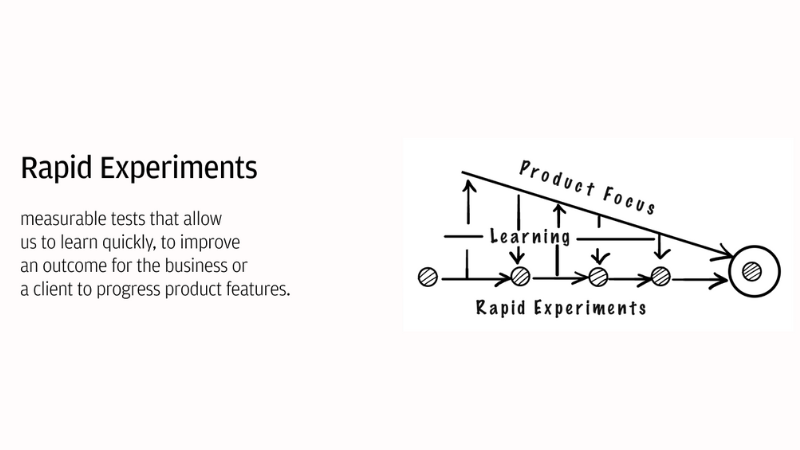The fastest way forward is a practical step toward an answer. Ambiguity can be an empowering part of a process. We take a step forward even though the road is not clear.
In celebration of Innovation Week 2023, a weeklong series of global events that celebrates innovation taking place across JPMorgan Chase, we’re discussing rapid experimentation and the importance of taking practical steps towards an answer. The practical steps we choose become an important part of the research – in our approach to experimentation, we create something quickly to understand the problem better. We cannot be right that quickly, but exploration moves the team forward together – an active collaboration.

Extending the Conversations
Good conversations are often the starting point for innovation – but it is important to quickly validate the hypothesis or identified problem. Running one or two-week rapid experimentation sprints can drive forward the idea spark from the conversation. Rapid Experimentation sprints also keep the team engaged in finding an answer together.
In physical spaces we often explore by taping out the floor. How much space do we need for this idea – a roll of tape and some floor space can help us figure it out. Anything to drive the conversation and learning forward.
Creating Feedback Loops
This kind of active exploration keeps us in constant contact with the end user without waiting for decisions on development tools. Try something quickly – the first two or three iterations are about making sure we understand the issue.
The tools for experiments are often close to the tools the business is already using. We have done rapid development with paper, email, macros, Python scripts, databases with static lookup tables and many other tools. What is available to us and what no-code or low-code techniques can we use to test quickly?
Scouting & Experimenting
As we identify potential research areas, we run one-or two-week research experiments to understand the problem better and leave a tangible outcome. This build-to-think process involves researching lightly, creating a tangible artifact and documenting insights.
That output often leads to a subsequent iteration, conversation, and another iteration – which reveals the product we should be building. The iterations often evolve into the final product.
We also can use available platforms and tools to test a new idea right away. If we wanted to test a chatbot idea, for example, we could test that today by setting up a chat thread with one person posing as the “bot” with a brief list of prompts and responses. We do not have to set up an entire tech platform - we can iterate gradually while we work out the platform possibilities.
Adding Experiment Tracks to Speed up Development
In longer development processes, multiple stakeholders, communities of users and documented research insights can slow down rapid iterations of the initial idea. Of course, the research and stakeholder input are important, but adding an experimentation track without dependencies can reveal a tangible outcome track along with the more complete research and larger sponsor group.
Running a track with dependencies removed allows us to build to learn. We can focus on a single user, a single feature, a single email, use a development team with only one developer and one designer – this small team and small focus enables very fast iterations and learning. Each roadblock becomes another opportunity to change. If we don’t have access to data, we create our own – if the team is comfortable with Excel, we use that as a prototyping tool. In this way, avoiding the roadblocks becomes our path forward.
Leaving Tangible Results Behind
Even in a rapid experimentation phase, we can leave valuable outcomes with the business. Some tangible results we have delivered to the business after one or two-week experiments include: improved reports, data models, data analysis results and interfaces, excel macros, design specifications, recommendations for light improvement, improved team communication and collaboration.
It is the bias toward action, which leads to this focus on experimentation. We are continually asking, “What can we do right away to solve the problem?” Multiple experiments join into a more robust and comprehensive solution. It is the bias toward action, which becomes a key driver in understanding more and bringing others along on the exploration.
Experimentation is not about “failing fast”, it is about learning quickly. There are many case studies with large tech innovators, which show that the number of experiments is the indicator of an excellent product – more experiments equal a better, more complete product.